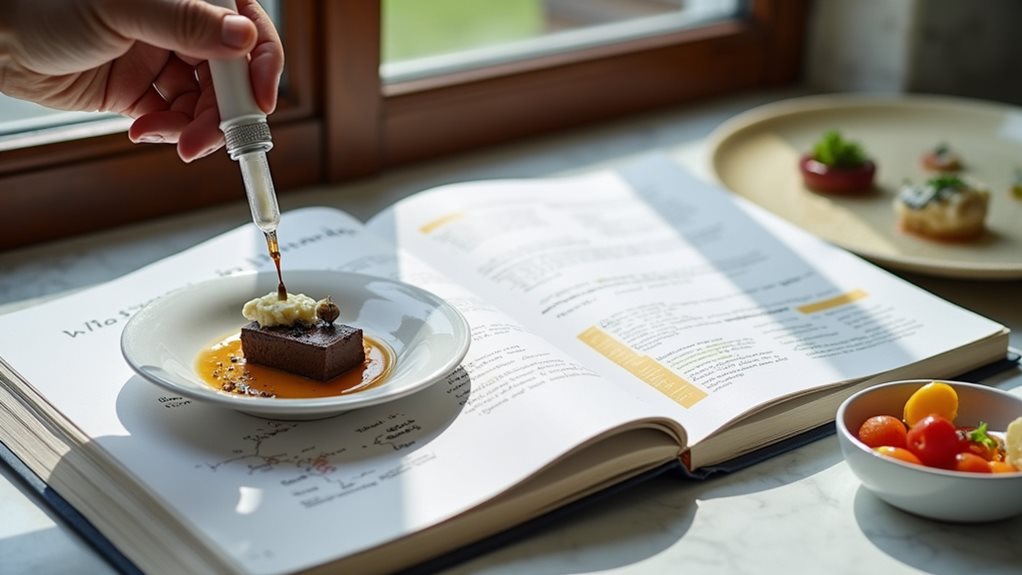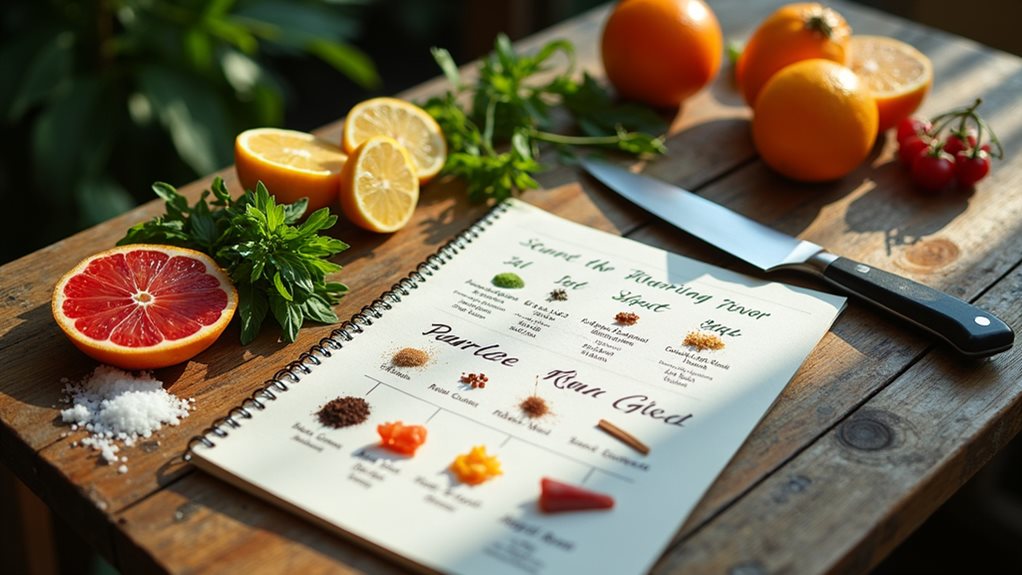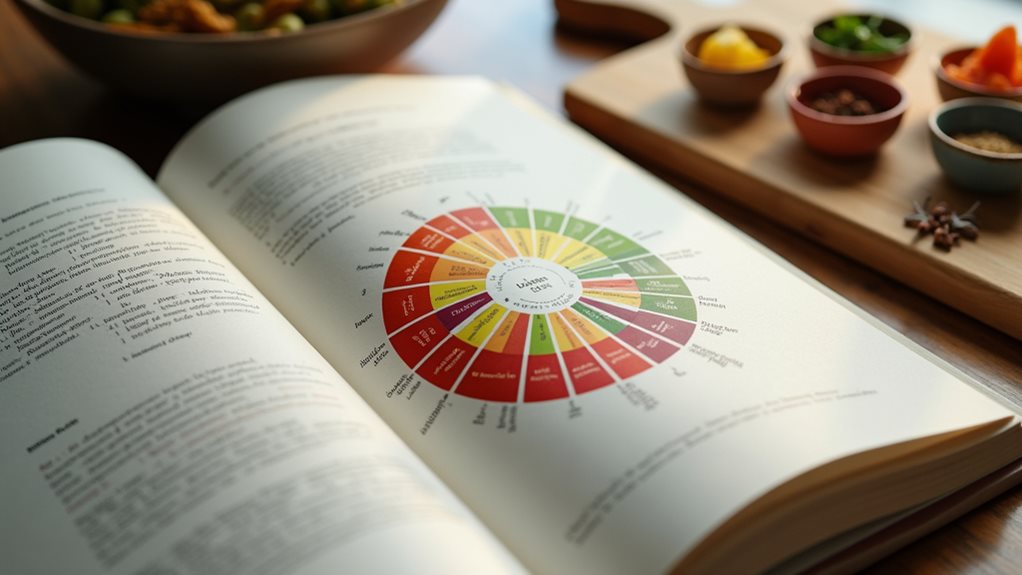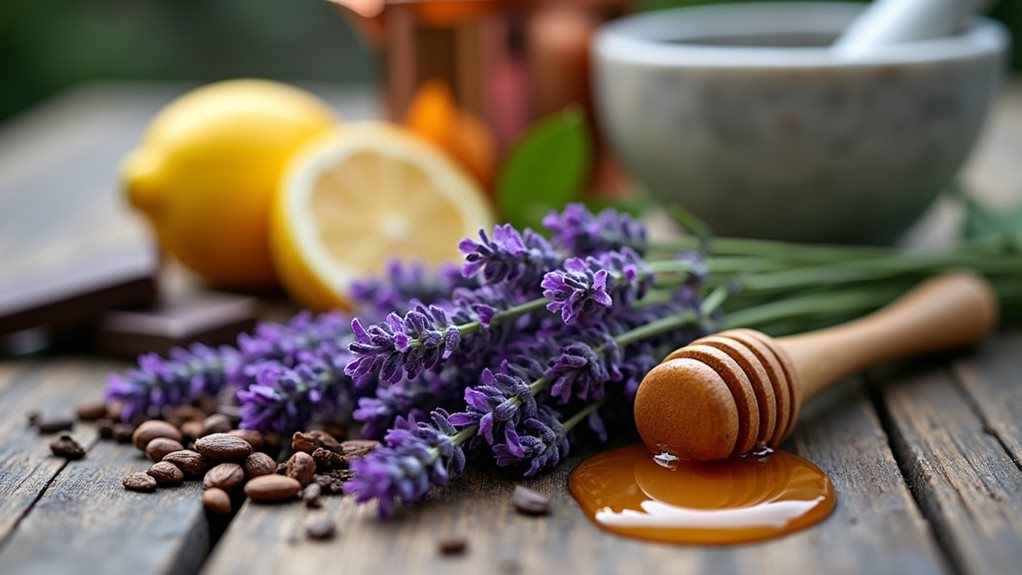Flavor pairing PDFs provide visual guides to ingredient combinations based on shared chemical compounds and complementary taste profiles. You'll find these resources organized by connecting lines or color codes that indicate compatibility strength and flavor intensity. Download an extensive chart to identify both classic and unexpected pairings, helping you balance taste elements like sweet, salty, sour, bitter, and umami in your cooking. Professional chefs and home cooks alike use these tools to create more nuanced, balanced dishes through scientific understanding of flavor relationships.
Understanding the Science Behind Flavor Compounds

While we often experience food through our taste buds, flavor is actually a complex interplay of chemistry and sensory perception. When you consume food, thousands of volatile compounds interact with receptors in your mouth and nose, triggering chemical interactions that your brain interprets as taste and aroma.
These flavor compounds are remarkably intricate – a single natural flavor might contain hundreds or even thousands of components. The distinction between natural and artificial flavors lies primarily in their source rather than their chemical composition. You're experiencing flavor perception when your brain processes signals from these chemical compounds.
The chemical symphony behind each bite reveals itself as your brain interprets thousands of molecular signals into coherent flavor.
Modern analytical techniques like gas chromatography have revolutionized our ability to identify these compounds with precision. AI-driven flavor pairing generators now utilize this data to suggest perfect flavor matches based on complementary compounds. Successful flavor pairing depends on identifying shared compounds between different ingredients that contribute to complexity and appeal.
Understanding these molecular foundations allows you to approach flavor pairing strategically rather than randomly. By recognizing which compounds create complementary sensations, you'll develop innovative combinations that surprise and delight the palate.
How to Use a Flavor Pairing Chart Effectively
When using a flavor pairing chart, you'll first need to identify the relationships between ingredients by looking for connecting lines or color-coded sections that indicate compatible flavor profiles.
You can then locate your base ingredient on the chart and follow the connections to discover complementary ingredients that share chemical compounds or flavor notes.
For best results, pay attention to intensity levels marked on sophisticated charts, which will help you balance strong flavors like blue cheese with milder companions or match equally robust ingredients for more powerful combinations. The Ultimate Fruit Flavor Pairing Chart is best viewed horizontally on mobile devices for optimal navigation and readability. Remember that thicker lines between ingredients generally indicate they have more shared compounds and potentially stronger flavor compatibility.
Reading Chart Relationships
To master flavor pairing charts, you'll need to understand how various elements interact on the page. Chart interpretation involves recognizing color codes and symbols that indicate flavor intensities and dominant notes. For users with visual impairments, flavor pairing charts should include accessibility features that ensure all users can access the information effectively.
When performing relational analysis, look for connecting lines or proximity patterns that suggest complementary or synergistic relationships between ingredients. The most successful combinations often appear when ingredients have shared flavor compounds, which increases the likelihood of creating harmonious taste experiences.
Pay attention to how charts distinguish between primary taste categories—sweet, salty, sour, bitter, and umami. You'll notice that well-designed charts often use consistent notation systems that reveal both obvious and surprising connections between foods.
For example, ingredients sharing similar flavor compounds will typically cluster together, while contrasting textures might be indicated through specific symbols. Understanding these visual relationships allows you to quickly identify potential pairings that balance flavors while creating memorable taste experiences.
Finding Compatible Ingredients
Finding the perfect ingredient partners begins with understanding how to effectively interpret flavor pairing charts. These visual tools map ingredient synergy by highlighting foods that share aromatic compounds, creating natural flavor compatibility.
When using a pairing chart, look for connecting lines between ingredients—these indicate shared compounds that often translate to harmonious combinations. Start with familiar pairings like apple-cinnamon, then branch into unexpected territory such as pineapple-blue cheese. Starting with a light hand when adding spices allows you to build flavors gradually without overwhelming the dish.
Don't just follow lines; consider flavor intensity, ensuring delicate flavors aren't overwhelmed by stronger ones.
Remember that cultural combinations, which have stood the test of time, often reveal profound flavor compatibility. Your own experiments can verify chart suggestions, helping you develop a personal understanding of which pairings truly shine in your kitchen creations.
Applying Intensity Levels
Why do some flavor combinations sing on your palate while others fall flat? The answer often lies in how you manage intensity levels between ingredients.
When using your flavor pairing chart, pay careful attention to intensity categorization—identifying whether an ingredient delivers light, delicate notes or bold, powerful flavors.
For successful flavor matching, pair ingredients with complementary intensity levels. Combining a delicate white fish with overpowering garlic might drown the fish's subtle qualities.
Instead, try matching similar intensities or create deliberate contrasts with purpose. When seeking harmony between ingredients, always consider that balance is crucial for creating successful culinary combinations. Consider blooming spices in oil before adding them to a dish to control and enhance their aromatic intensity. You'll discover that balancing a bold flavor with a milder counterpart can create dynamic tension in your dish. Understanding the four basic tastes enhances your ability to create balanced intensity levels that elevate your culinary creations.
Advanced chefs often use technological approaches to analyze compound intensity, but you can start by simply categorizing your ingredients as mild, medium, or bold before making combinations.
Essential Tools for Finding Complementary Ingredients
When seeking complementary ingredients for your culinary creations, you'll find that visual pairing charts and digital flavor databases are indispensable tools.
Visual resources, such as flavor wheels and pairing maps, allow you to quickly identify potential matches based on established culinary principles and ingredient affinities.
Digital flavor databases take this a step further by providing access to extensive collections of ingredient profiles, scientific analyses, and chef-tested combinations that you can search by flavor component, cuisine type, or seasonal availability. The most effective pairing tools utilize gas chromatography analysis to identify the shared aromatic compounds between ingredients.
Visual Pairing Resources
To master the art of flavor pairing, you'll need access to specialized visual tools that transform complex flavor relationships into accessible knowledge.
Flavor networks and matrices provide systematic approaches to understanding how ingredients connect through shared compounds, while visual pairing techniques help you discover unexpected combinations that elevate your cooking.
You'll find tremendous value in resources like The Flavor Matrix book and flavor wheels that categorize taste profiles.
Modern flavor visualization tools include AI-powered applications like FlavorGraph that predict successful pairings based on molecular science.
These visual aids bridge the gap between chemistry and culinary art, enabling you to confidently experiment with contrasting textures and complementary profiles.
Whether you're a professional chef or home cook, these resources will revolutionize how you combine ingredients to create memorable dishes.
For example, understanding how the natural sweetness of carrots balances with warming spices creates harmonious flavor profiles in dishes like spiced carrot soup.
Digital Flavor Databases
Digital flavor databases represent the technological evolution of traditional pairing methods, offering unprecedented access to extensive flavor information at your fingertips.
Platforms like FlavorDB and FooDB compile thousands of flavor molecules, creating intricate maps of ingredient relationships through sophisticated data visualization techniques.
You'll find these resources invaluable for flavor analysis, as they reveal unexpected connections between seemingly disparate ingredients.
Using AI-powered tools like FlavorGraph, you can explore culinary innovation through graphical interfaces that highlight molecular similarities across cultural boundaries.
These databases employ flavor chemistry principles to suggest complementary pairings, supporting recipe optimization efforts that would be impossible through trial and error alone.
Advanced sensory evaluation data within these platforms helps you identify subtle flavor overlaps, making them essential companions for modern chefs seeking evidence-based inspiration.
The Art and Science of Balancing Taste Elements

Balancing taste elements in cooking represents both an artistic endeavor and a scientific pursuit that transforms ordinary ingredients into extraordinary dishes.
When you're balancing sweetness with other flavors, consider how acidity from citrus or vinegar can cut through excessive sugar, enhancing flavors rather than masking them. Natural sweeteners like fruits offer healthier alternatives that integrate more harmoniously with other components.
To master flavor balance effectively:
- Taste iteratively throughout the cooking process
- Layer flavors by building on a flavorful base
- Create contrast by pairing complementary elements like sweet-salty or fat-acid
- Allow dishes to rest before serving to integrate flavors fully
This scientific approach to taste supports the artistic side of cooking, ensuring your dishes achieve perfect harmony. Studies show that color contrasts significantly enhance visual impact and perception of flavors, making presentation an essential component of the overall taste experience.
Cultural Traditions Shaping Modern Flavor Combinations
Cultural traditions across the globe have profoundly shaped today's most innovative flavor combinations, creating a rich tapestry of taste that continues to evolve with each culinary generation.
When you explore traditional pairings like Japan's umami-rich dishes or Mexico's complex mole sauces, you're experiencing culinary heritage that spans centuries. These combinations aren't merely delicious—they're vehicles for cultural storytelling that connect communities through shared gastronomic experiences.
As migration patterns have shifted throughout history, flavor profiles have merged and transformed. You'll find this evident in fusion cuisines like Korean tacos or Asian-inspired burgers, where chefs expertly blend techniques from distinct traditions. American barbecue demonstrates this cultural fusion through its diverse regional sauce traditions that reflect historical influences from indigenous, European, and African cooking methods.
Unlocking Unexpected Pairings With Chemical Analysis

Behind every extraordinary flavor pairing lies a fascinating chemical story—one you can now explore through modern scientific analysis.
When you understand the shared chemical compounds between ingredients, you'll discover unexpected combinations that delight the palate and challenge culinary conventions.
Modern tools can help you create innovative pairings:
- Use scientific databases like Flavornet to identify ingredients with matching aroma profiles.
- Employ molecular gastronomy techniques to isolate and combine specific flavor compounds.
- Analyze the balance of basic tastes (sweet, sour, umami) to create complementary experiences.
- Explore cross-cultural pairings that break traditional boundaries, like caviar with white chocolate.
These approaches transform cooking from intuition to science-based creativity, revealing why shellfish and vanilla—seemingly disparate ingredients—create harmonious symphonies of flavor when their shared chemical compounds interact.
From Classic to Creative: Evolving Your Flavor Repertoire
As you journey from familiar flavor combinations toward more adventurous territory, understanding the progression from classic to creative pairings becomes essential for culinary creativity.
Begin with timeless duos like strawberry-banana or chocolate-hazelnut before expanding your repertoire. These foundations teach balance while building confidence for bolder exploration.
When you're ready to venture further, experiment with contrasting elements—try jalapeño with mango or chocolate with cayenne pepper.
These unexpected combinations create memorable taste experiences that challenge conventional expectations. Consider how tropical fusions like coconut-blackberry or savory innovations like maple-bacon can transform ordinary dishes into extraordinary creations.
The contrast of sweet and salty found in watermelon and feta creates a delightful flavor harmony that exemplifies how opposing taste profiles can complement each other beautifully.
Your flavor exploration needn't follow rules; it's about discovering what resonates with your palate.
The progression from classic to creative isn't linear but rather a branching path of delicious possibilities.
Practical Applications for Home Cooking Experimentation
Transforming knowledge about flavor pairings into delicious meals requires both technique and experimentation in your home kitchen. The journey of flavor exploration begins with understanding how to build and balance taste components in everyday cooking.
Your culinary experimentation should follow a methodical yet creative approach, constantly tasting and adjusting as you work.
- Start with a flavor foundation – Use the "Starting 5" (salt, pepper, olive oil, onion, garlic) as your base, then build complexity by adding herbs and spices.
- Practice multiphase cooking – Add ingredients at different times to create layered flavors.
- Maintain a feedback system – Taste throughout the cooking process to adjust seasoning.
- Document successful combinations – Create your personal flavor chart based on pairings you've enjoyed.
Consider incorporating fermented ingredients as flavor boosters to introduce complex umami notes and tangy dimensions to your dishes.
Download Our Comprehensive Flavor Pairing Guide
While mastering flavor combinations might seem overwhelming, our downloadable Flavor Pairing Guide simplifies this complex culinary art into practical, easy-to-follow resources.
You'll discover scientifically backed pairings organized by flavor profiles—sweet, salty, sour, bitter, and umami—enabling you to create balanced, innovative dishes with confidence.
Our guide tracks emerging flavor trends while providing tips for ingredient sourcing that elevates your culinary creations.
You'll find specialized sections on fruit pairings, spice combinations, and cross-cultural flavor profiles that aren't typically found in standard cookbooks.
The downloadable PDF format allows easy reference in your kitchen or grocery shopping trips, complete with visual charts mapping complementary flavor relationships.
Whether you're an amateur cook or seasoned chef, this guide will transform how you approach flavor experimentation in your everyday cooking.
Explore exciting dessert transformations with unexpected pairings like cinnamon-spiced goat cheese cheesecake with balsamic strawberries that challenge traditional flavor boundaries.
Frequently Asked Questions
How Do Allergies Affect Flavor Pairing Recommendations?
If you have allergies, your flavor pairing options must consider allergy-friendly alternatives. Your flavor sensitivity might be altered, requiring innovative combinations that prioritize safety while still delivering exciting taste experiences.
Can Flavor Pairings Help Reduce Food Waste?
You'll reduce waste through creative flavor pairings that enhance food preservation and maximize ingredient utilization. By discovering complementary flavors for peels, stems, and "ugly" produce, you're turning potential waste into innovative, delicious dishes.
Do Seasonal Changes Impact Optimal Flavor Combinations?
Yes, you'll find seasonal changes directly affect ideal flavor combinations. As ingredients shift through seasons, their flavor intensity varies, requiring you to adjust pairings to maximize innovation potential with fresh, seasonal ingredients.
Are There Flavor Pairings That Enhance Nutritional Benefits?
While incomplete, nutritional synergy theory proves compelling. You'll boost your health with smart food combinations: turmeric-black pepper increases anti-inflammatory properties, spinach-citrus enhances iron absorption, and bean-rice pairings create complete proteins your body craves.
How Do Cooking Methods Alter Recommended Flavor Combinations?
Cooking techniques greatly transform flavor intensity – high-heat methods like grilling intensify pairings while gentle techniques preserve delicate combinations. You'll find that roasting enhances earthy pairings, while steaming works best with subtle flavor profiles.
Final Thoughts
You're now equipped to telegraph your own flavor messages across the culinary wires of your kitchen. By understanding the chemical compounds that connect seemingly disparate ingredients, you'll develop an intuitive sense for what works together. Remember, mastering flavor pairing isn't just about following charts—it's about developing your palate's wisdom. Download our PDF guide today, and transform your cooking from predictable to extraordinary with confidence and creative precision.















